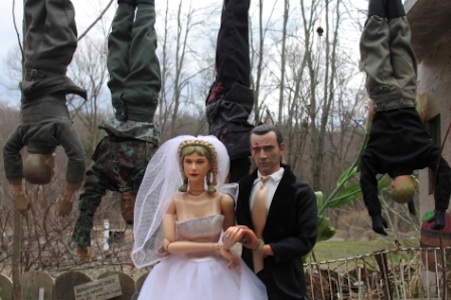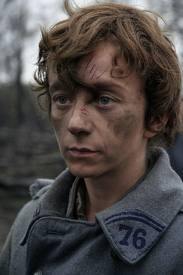There’s no such thing as a truly anti-war film, Francois Truffaut once said. By depicting the adventure and thrill of combat, war movies can’t help but glorify their subject, fueling fantasies of spectacular, heroic violence. It’s a case where the sensational beauty of cinema works against our humanist impulses rather than for them. I’m not a fan of war movies as a general matter of principle. But in recent years, I’ve seen a couple of films with unique approaches to war movies, and that brings humanity back into focus.
Marwencol, by Jeff Malmberg, is a striking, unusual documentary about Mark Hogancamp, the victim of a brutal attack who recovers by using dolls and action figures to create a fantasy World War II version of his life. Hogancamp’s world is a highly immersive work of art, fashioned after the mythology of World War II as found in countless war movies. It’s a world of GI heroes and Nazi villains, all completely under his control, and that allows him to dramatize his past traumas and personal demons. Hogancamp’s reenactments reveal something about how war movies take on a life of their own in our imaginations, and how they fuel our need to play out our fantasies of violence. But Hogancamp’s version of the war has a redemptive, reconciling impulse as well. Hogancamp’s war lets German soldiers fraternize with Americans. And women take on prominent roles as warriors who come to his rescue.
A female protagonist helps flip the war movie script in Serge Bozon’s La France. She’s a French villager in World War I who disguises herself as a man and joins a troop of soldiers in order to search for her missing husband. Like Marwencol, La France takes a certain nostalgic comfort in the vintage visuals of war movies. But while most war films fetishize violence as a spectacle, La France fetishizes the feelings of longing and displacement caused by war. These lost soliders are perhaps the most delicate souls to don uniforms and carry guns in movie history. They are united in a profound state of loneliness, which they express in a series of unexpected 60s-style pop tunes. The musical numbers are totally anachronistic, but they fit the film’s lyrical mood and lift it well beyond the realm of realism. One gets the sense that these characters are to Serge Bozon what the dolls are to Mark Hogancamp. In a sense, all war movies amount to directors playing with doll sets. But unlike in most war movies, the soldier dolls in Marwencol and La France are not meant to stage a violent spectacle, but to explore a perilous terrain of complex emotions. Now that is a cause worth fighting for.
Kevin B. Lee is Editor in Chief of IndieWire’s PressPlay Video Blog, Video Essayist for Fandor Keyframe, and contributor to Roger Ebert.com. Follow him on Twitter.





